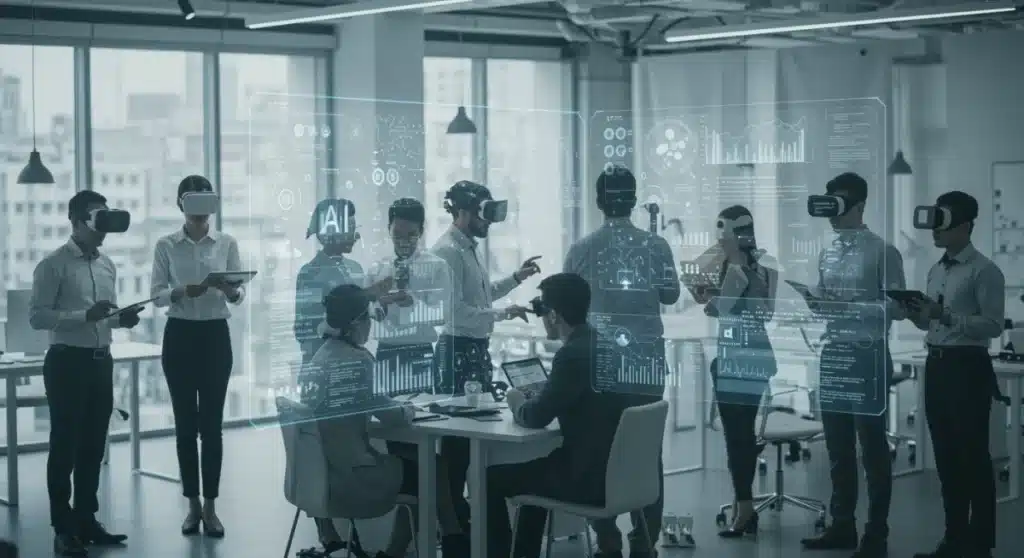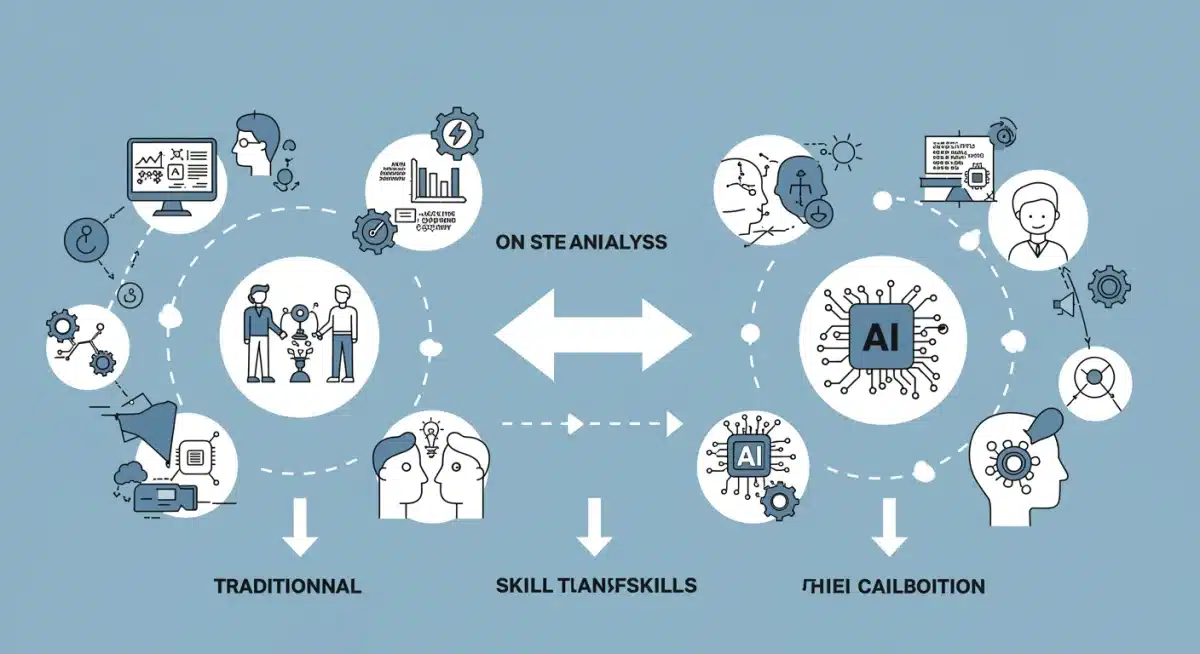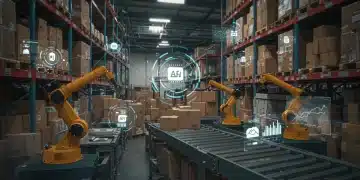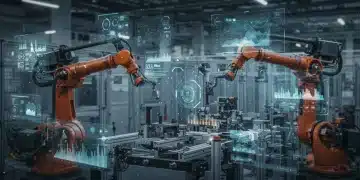AI-Powered Workforce: Training Strategies for US Companies in 2025

US companies are urgently developing AI workforce training strategies for 2025 to adapt to rapidly evolving technological landscapes, focusing on upskilling and reskilling employees for AI integration and sustained competitive advantage.
As the technological landscape rapidly evolves, the imperative for Building an AI-Powered Workforce: Training Strategies for US Companies to Implement in 2025 becomes clearer each day. Businesses across the nation are now facing a crucial juncture: adapt or risk obsolescence in an increasingly AI-driven economy.
The Urgent Need for AI Readiness in the US Workforce
The acceleration of AI integration across industries has placed an unprecedented demand on the US workforce. Companies are realizing that merely adopting AI tools is insufficient; the true competitive edge lies in employees capable of effectively interacting with, managing, and innovating alongside these technologies. This shift necessitates a proactive and comprehensive approach to skill development, moving beyond traditional training models.
Recent reports, including those from the World Economic Forum and various tech industry analyses, consistently highlight that AI will displace certain jobs while simultaneously creating new ones, many of which require advanced digital literacy and AI proficiency. The challenge for US companies is to bridge this skills gap rapidly and efficiently.
Identifying Critical AI Skills Gaps
Before implementing any training, companies must first understand where their current workforce stands in terms of AI readiness. This involves a thorough assessment of existing skill sets against future demands. Key areas often identified as lacking include:
- Data literacy and analytics
- Machine learning fundamentals
- Ethical AI principles and governance
- Human-AI collaboration and interface design
These gaps are not uniform across all departments or roles, making a generalized training approach less effective. Instead, a targeted strategy based on departmental needs and individual career paths proves more beneficial.
Developing Comprehensive Upskilling and Reskilling Programs
To effectively build an AI-powered workforce, US companies must invest in both upskilling existing employees and reskilling those whose roles are most impacted by automation. These programs need to be dynamic, accessible, and aligned with strategic business objectives. The goal is not just to teach new tools but to foster a mindset of continuous learning and adaptability.
Many leading organizations are partnering with educational institutions and specialized training providers to develop custom curricula. This ensures that the content is both academically rigorous and directly applicable to the company’s operational needs and specific AI deployments.
Leveraging Micro-Credentialing and Online Platforms
The traditional, lengthy degree programs are often impractical for rapid workforce transformation. Micro-credentialing and online learning platforms offer flexible and efficient alternatives. These allow employees to acquire specific AI competencies in shorter, modular formats, often while continuing their day-to-day work.
- Coursera, edX, and LinkedIn Learning offer extensive AI courses.
- Custom internal platforms can be developed for proprietary AI tools.
- Certification programs from tech giants like Google, AWS, and Microsoft validate new skills.
This approach democratizes access to AI education, enabling a broader segment of the workforce to participate and benefit, thereby accelerating the overall transition to an AI-powered enterprise.
Fostering an AI-Ready Culture and Leadership Buy-in
Technological training alone is insufficient without a supportive organizational culture. Leadership buy-in is paramount; executives must champion AI initiatives and demonstrate their commitment to workforce development. This includes allocating adequate resources, setting clear expectations, and celebrating learning milestones. A culture that embraces experimentation, continuous learning, and intelligent risk-taking is essential for successful AI integration.
Employee engagement is also critical. Companies must communicate the benefits of AI training clearly, addressing fears about job displacement by emphasizing opportunities for growth and enhanced roles. Transparency and open dialogue can mitigate resistance and encourage proactive participation in training programs.

Integrating AI Ethics and Responsible AI Practices
As AI becomes more prevalent, understanding its ethical implications is no longer a niche concern but a fundamental skill for all employees. Training programs must incorporate modules on responsible AI development and deployment, bias detection, data privacy, and algorithmic transparency. This ensures that the AI-powered workforce operates with integrity and adheres to societal values.
Companies are increasingly establishing internal AI ethics boards and guidelines. Employees need to be aware of these frameworks and understand their role in upholding them. This proactive approach helps prevent potential pitfalls and builds public trust in AI applications.
Implementing Experiential Learning and Practical Application
Theoretical knowledge of AI is valuable, but practical experience is indispensable. US companies are shifting towards experiential learning models where employees can apply their newly acquired AI skills in real-world scenarios. This includes hackathons, AI-focused projects, and simulations that mimic actual business challenges.
Mentorship programs, where experienced AI practitioners guide new learners, are also proving highly effective. This hands-on approach solidifies understanding, builds confidence, and fosters a deeper engagement with AI technologies. It also allows companies to identify and nurture internal AI talent.
Creating Internal AI Innovation Labs
Some forward-thinking companies are establishing internal AI innovation labs or sandboxes. These environments provide a safe space for employees to experiment with AI tools, develop prototypes, and test new applications without fear of disrupting core operations. These labs can become incubators for new AI-driven products, services, and process improvements, directly contributing to business growth.
Furthermore, these labs offer continuous learning opportunities, allowing employees to stay abreast of the latest AI advancements and share knowledge across departments. This collaborative approach accelerates the overall AI transformation within the organization.
Measuring Impact and Continuous Adaptation
The success of any AI workforce training strategy hinges on its ability to deliver measurable results and adapt to evolving technological landscapes. Companies must establish clear key performance indicators (KPIs) to track the effectiveness of their training programs. This includes assessing skill acquisition, project success rates, and the overall impact on productivity and innovation.
Regular feedback loops from employees and managers are crucial for refining training content and delivery methods. The AI field is dynamic, meaning that training strategies implemented in 2025 will likely need continuous adjustment and updates to remain relevant and effective throughout the decade.
Future-Proofing the Workforce Through Agility
An agile approach to workforce development is essential. This means being prepared to pivot training priorities as new AI breakthroughs emerge or as business needs shift. Companies that build a strong foundation in foundational AI literacy and foster a culture of lifelong learning will be best positioned to navigate future disruptions.
Regular reviews of skill inventories and market trends will ensure that training investments are always aligned with the most pressing needs. This continuous cycle of assessment, training, application, and re-evaluation forms the backbone of a truly AI-powered and resilient workforce.
| Key Point | Brief Description |
|---|---|
| Skill Gap Assessment | Identify current workforce AI skills versus future needs to tailor effective training programs. |
| Upskilling & Reskilling | Implement targeted programs, often leveraging online platforms and micro-credentials, for existing employees. |
| Cultural Transformation | Foster an AI-ready culture with strong leadership buy-in and a focus on ethical AI practices. |
| Experiential Learning | Provide hands-on experience through projects, hackathons, and innovation labs for practical skill application. |
Frequently Asked Questions About AI Workforce Training
AI workforce training is crucial as AI rapidly reshapes industries, creating new job roles and demanding advanced digital skills. Companies must equip employees to effectively leverage AI tools, maintain competitiveness, and drive innovation in a rapidly evolving technological landscape.
An effective strategy includes thorough skill gap assessments, targeted upskilling/reskilling programs, cultural transformation with leadership buy-in, integration of ethical AI principles, and hands-on experiential learning. These components ensure comprehensive development and practical application of AI skills.
Success can be measured through various KPIs, including skill acquisition rates, employee engagement in AI projects, improvements in productivity, and the development of new AI-driven solutions. Regular feedback and continuous adaptation of programs are also vital for ongoing effectiveness.
Ethical AI is fundamental. Training must cover responsible AI development, bias detection, data privacy, and transparency. This ensures employees understand the societal implications of AI, promoting its responsible and fair application across all business operations and decision-making processes.
Online platforms and micro-credentials are excellent for foundational knowledge and specific skill acquisition due to their flexibility. However, they are best complemented by hands-on experiential learning, internal projects, and mentorship to ensure practical application and deeper understanding of complex AI concepts.
Looking Ahead: The Evolving Landscape of AI and Work
The rapid pace of AI development means that the strategies implemented in 2025 are merely the beginning of an ongoing journey. US companies must view AI workforce training not as a one-time project but as a continuous investment in their human capital. The ability to adapt quickly, embrace new technologies, and foster a culture of lifelong learning will determine which organizations thrive in the AI-powered future. Expect to see increased collaboration between industry, academia, and government to create national frameworks for AI literacy and skill development, ensuring the US maintains its competitive edge on the global stage. The focus will shift towards human-AI collaboration, augmenting human capabilities rather than simply replacing them, necessitating innovative approaches to education and professional development.





